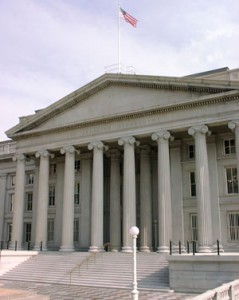Dollar’s Dominance Wanes
Jul 31, 20202.2K Shares286.8K Views
U.S. Department of Treasury (U.S. Department of Treasury)
Part 1: U.S. Failing to Defend Dollar
The U.S. national debt is rapidly rising. If Congress signs off on the Bush administration’s $700-billion rescue plan for Wall Street’s troubled financial markets, the debt ceiling will have to be raised to $11.3 trillion. The debt was $9.4 trillion in March. An immediate response to the bailout plan was a falling dollar, which so far has lost half its summer gains in trading this week.
A big chunk of U.S. debt is owned by foreign investors whose currencies’ values are rising relative to the dollar. Already, many have sustained investment losses because of the dollar’s fall in value. With the dollar now losing ground because of the financial crisis on Wall Street, at what point will foreign investors stop buying U.S. Treasuries entirely and throw the country into a debt crisis? Indeed, why hasn’t Washington experienced a sovereign debt crisis before?
The real reason the United States has avoided such a fate is that it finances its debt in dollars. That means Washington can literally print dollars to service and repay its obligations.
America’s special status derives in part from the fact that the dollar is the world’s major reserve and trading currency. The dollar was also once pegged to the gold standard, though that peg, of course, is long gone. But the aura of stability created by the strength of U.S. economic and military power has continued to support the dollar.
But the dollar’s dominance in world markets may be coming to an end. Even when the dollar was rising this year, there was talk of re-denominating trade flows and pricing commodities like oil and agricultural produce in other currencies. Now, with the greenback reversing course, such talk is likely to return.
Illustration by: Matt Mahurin
They is no shortage of signs that the dollar has fallen out of global favor. In the early 1970s, Japanese exports were invoiced almost exclusively in dollars; today only 50 percent are. The Taj Mahal does not accept payment in dollars for its admission fee — only rupees, India’s currency. Some supermodels, even drug dealers, want to be paid in euros, not dollars.
Foreign investors, including central banks, have reduced their dollar-based investments. The percentage of dollars in total world reserves has fallen from a high of 72 percent to around 60 percent. Dollars held outside the U.S. have declined from 1.83 percent of world trade in 2002 to 1.22 percent in 2006.
Foreign investor demand for U.S. Treasury bonds has also softened. Low nominal (negative real) interest rates and the weakness of the dollar are to blame. So is the declining credibility of the Federal Reserve and U.S. Treasury.
For example, foreign investors in Fannie Mae and Freddie Mac debt had long regarded it as “implicitly” backed by the U.S. government. They, as well as more than 60 central banks, hold more than $1,400 billion in debt securities issued by of U.S. agencies, including Fannie Mae and Freddie Mac.
But the travails brought on by the housing meltdown in the United States raised questions about the two mortgage giants’ ability to met their debt obligations. On July 23, the Financial Times reported that the U.S. embassy, after Kuwait’s minister of finance announced that the fund was no longer planning to invest in the agencies’ debt, called the Kuwait Investment Authority, the world’s sixth-largest sovereign wealth fund, to reassure it that bonds issued by Fannie Maeand Freddie Macwere sound. As it turned out, foreign-investor concerns that the mortgage companies would default on their debt in part triggered the U.S. government’s takeover of Freddie and Fannie.
That was in early September. As October nears, Washington needs an estimated $1 trillion to complete its rescue of troubled financial institutions weighed down by toxic mortgages and mortgaged-backed securities. Will foreign investors continue to step up and buy U.S. debt at a time when the creditworthiness of the world’s biggest borrower is under a cloud?
Scrooge’s nightmare, described by Charles Dickens, in which “solid” British assets are changed into “a mere United States security” may become a reality.
At a minimum, Washington will probably have to pay higher interest rates to finance its insatiable borrowing. Ultimately, it may even be forced to finance its debt in a foreign currency. This would expose Washington to currency fluctuations. But, most important, it would not be able to service its debt by printing money. Like all borrowers, Washington would face the discipline of its creditors.
For the moment, however, the dollar is hanging on -– barely. To a degree, this reflects weakness in the euro and yen because of Europe’s and Japan’s economic slowdowns.
The dollar is also a beneficiary of the “too big to fail” syndrome. Foreign investors — especially central banks and sovereign wealth fund investors in East and South Asia, Russia and the Persian Gulf — hold substantial dollar investments that would sustain catastrophic losses if the U.S. were to default on its debt.
The International Monetary Fund estimates that the Gulf Cooperation Council — Saudi Arabia, the United Arab Emirates, Qatar and other Gulf States — could lose $400 billion if they stopped pegging their currencies to the dollar.
So what must the U.S. do?
In 1989, economist John Williamson described a set of economic prescriptions, which he coined as the Washington consensus, that became the “standard” reform package that the International Monetary Fund imposed on countries wracked by economic crisis. The controversial–and highly criticized–package included calls for more fiscal policy discipline; less public spending on subsidies; tax reform; market-determined interest rates; competitive currency exchange rates; trade liberalization; reducing barriers to foreign direct investment; privatization of state enterprises; and deregulation. While many regard this formula as discredited, others still attest to it.
These prescriptions were intended for emerging markets. But, certain aspects of the package could be seen as appropriate for the world’s leading economic power — and premiere borrower.
Some of these elements–fiscal discipline, for example–will be politically difficult to achieve in Congress. Moves to cut farm subsidies face deep-seated opposition. Tax reform seems unattainable. And welcoming more foreign investment is politically dicey. Surveys show that most Americans want U.S. companies to remain in U.S. hands.
But the weak dollar has triggered the “closing down sale” of U.S. assets. On Sept. 29, shareholders of InBev, a Belgian-based brewer, will vote on the company’s $52 million bid for U.S rival Anheuser-Busch, the brewer of Budweiser, the quintessential American beer. Abertis Infraestructuras, a Spanish company teamed with Citigroup, bid $12.8 billion** **to lease and operate the Pennsylvania Turnpike, America’s oldest major toll road, for the next 75 years. And sovereign wealth funds have provided much of the capital needed to re-capitalise the U.S. financial system buffeted by the housing meltdown. In return, they have acquired major stakes in U.S. companies.
Stephen Schwarzman, head of Blackstone, a private equity firm, put it this way in an opinion piece in the Financial Times in June: “The U.S. is the world’s largest debtor nation and we are now in an uneasy relationship with our creditors. … If we were forced to rely mostly on domestic borrowing, we would have to pay very high interest rates. The consequences would be increased inflation, a dollar falling even faster and very slow [or negative] economic growth. If the investment climate for [sovereign wealth funds]is poor in the U.S., the countries with large dollar reserves (which are the owners of most of the sovereign wealth funds) could … look for alternatives.”
The “adjustment” may be under way. The dry, measured economic prose of the Washington consensus does not capture its human elements. It would require reductions in U.S. real wages and living standards on a scale unfathomable to most Americans.
If you doubt this, just ask the average citizen of any country that has taken the IMF’s “cure.”
Despite its gargantuan appetite for borrowing, there is much to admire about the United States. It remains far wealthier than the new economic titans China and India. It is peerless as a science and technology powerhouse, accounting for 40 percent of total world spending on research and development. Between 1993-2003, America’s growth rate in patents averaged 6.6 percent a year, compared to 5.1 percent for the European Union and 4.1 percent for Japan. America’s economy, with its growing population, secure legal and property rights and well-developed financial markets, remains highly attractive to investors.
But as Warren Buffett 2006 letter to shareholdersobserved, “Foreigners now earn more on their U.S. investments than we do on our investments abroad … In effect, we’ve used up our bank account and turned to our credit card. And, like everyone who gets in hock, the U.S. will now experience ‘reverse compounding’ as we pay ever-increasing amounts of interest on interest. …. no matter how rich you are, borrowing on top of borrowing is not a great long-term financial plan. I believe that at some point in the future, U.S. workers and voters will find this annual ‘tribute’ (of interest payment on the debt) so onerous that there will be a severe political backlash … How that will play out in markets is impossible to predict– but to expect a ’soft landing’ seems like wishful thinking.”
And here’s what Economist magazine said: “[P]ublic credit depends on public confidence…The financial crisis in America is really a moral crisis, caused by the series of proofs …that the leading financiers who control banks, trust companies and industrial corporations are often imprudent, and not seldom dishonest. They have mismanaged…funds and used them freely for speculative purposes. Hence the alarm of depositors and a general collapse of credit…”
Those words appeared in the Nov. 2, 1907, issue of the magazine in response to the Panic of 1907, when a crashing stock market led to a run on banks and trust companies.
The U.S. faces a challenge to reestablish its economic credentials. Without drastic and radical action, America’s ability to continue to borrow from foreign investors to finance its escalating debt is likely to become ever more difficult.
Satyajit Das is a risk consultant and author of “Traders, Guns & Money: Knowns and Unknowns in the Dazzling World of Derivatives.” *
At the time of publication the author or his firm did not own any direct investments in securities mentioned in this article though he may be an owner indirectly as an investor in a fund.

Hajra Shannon
Reviewer
Latest Articles
Popular Articles

